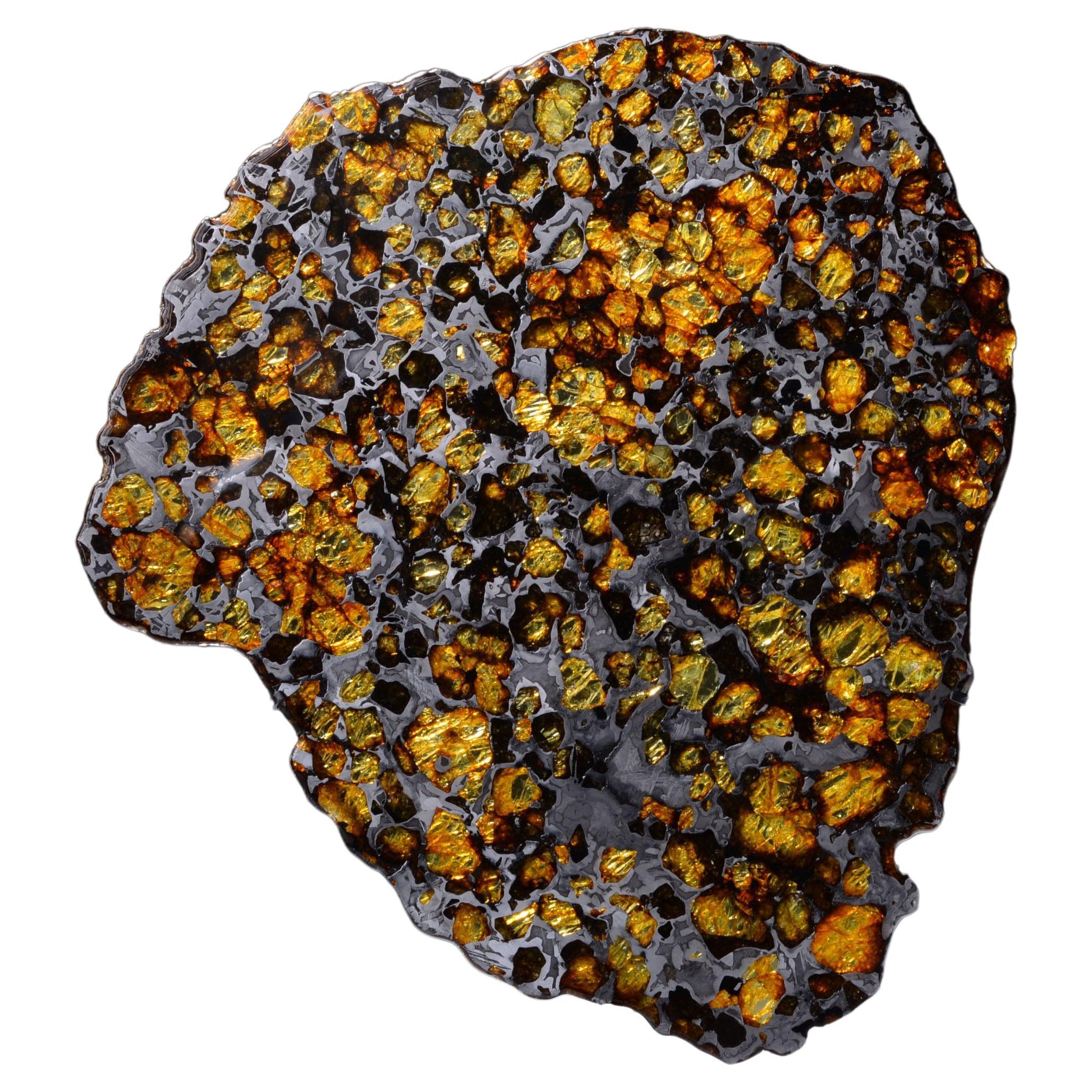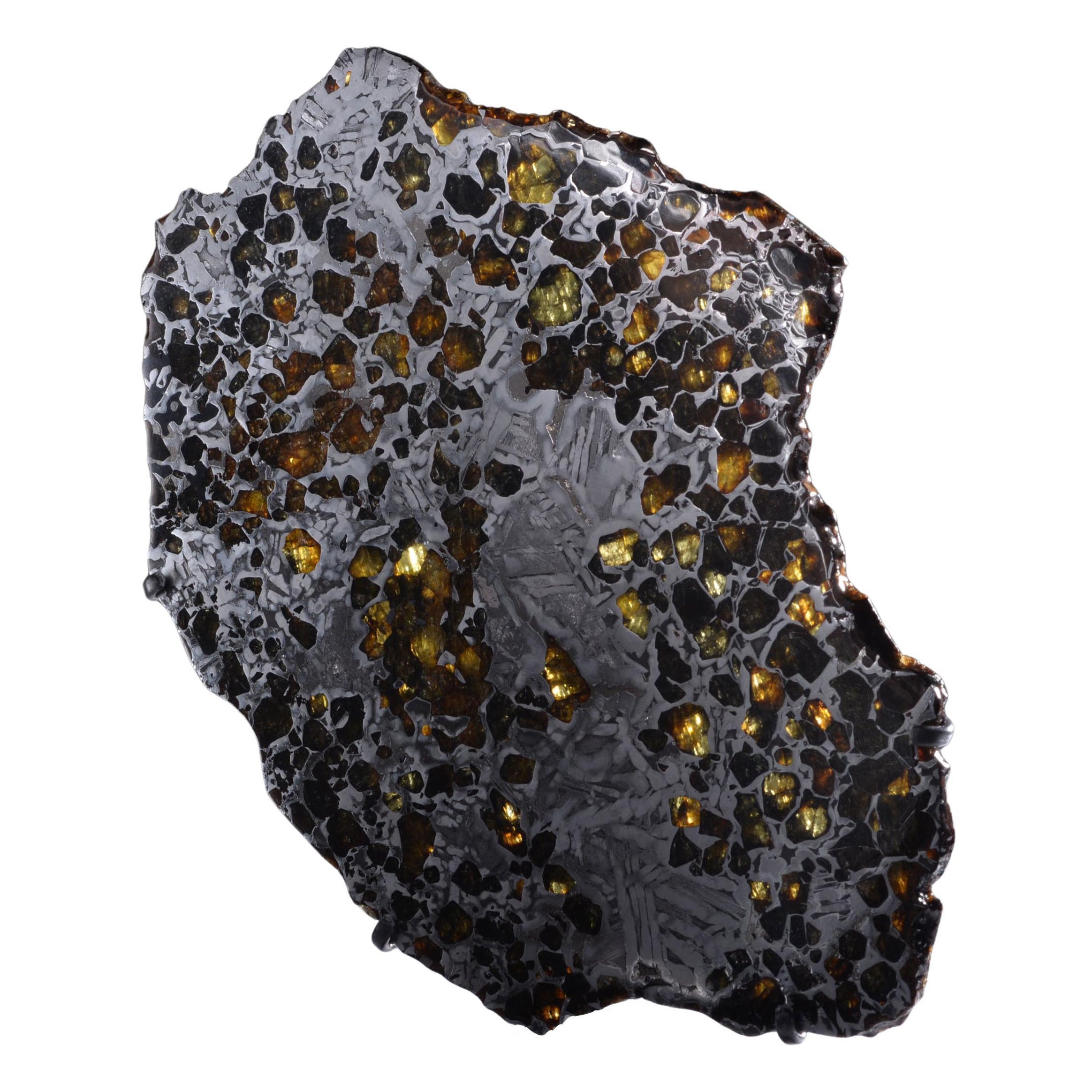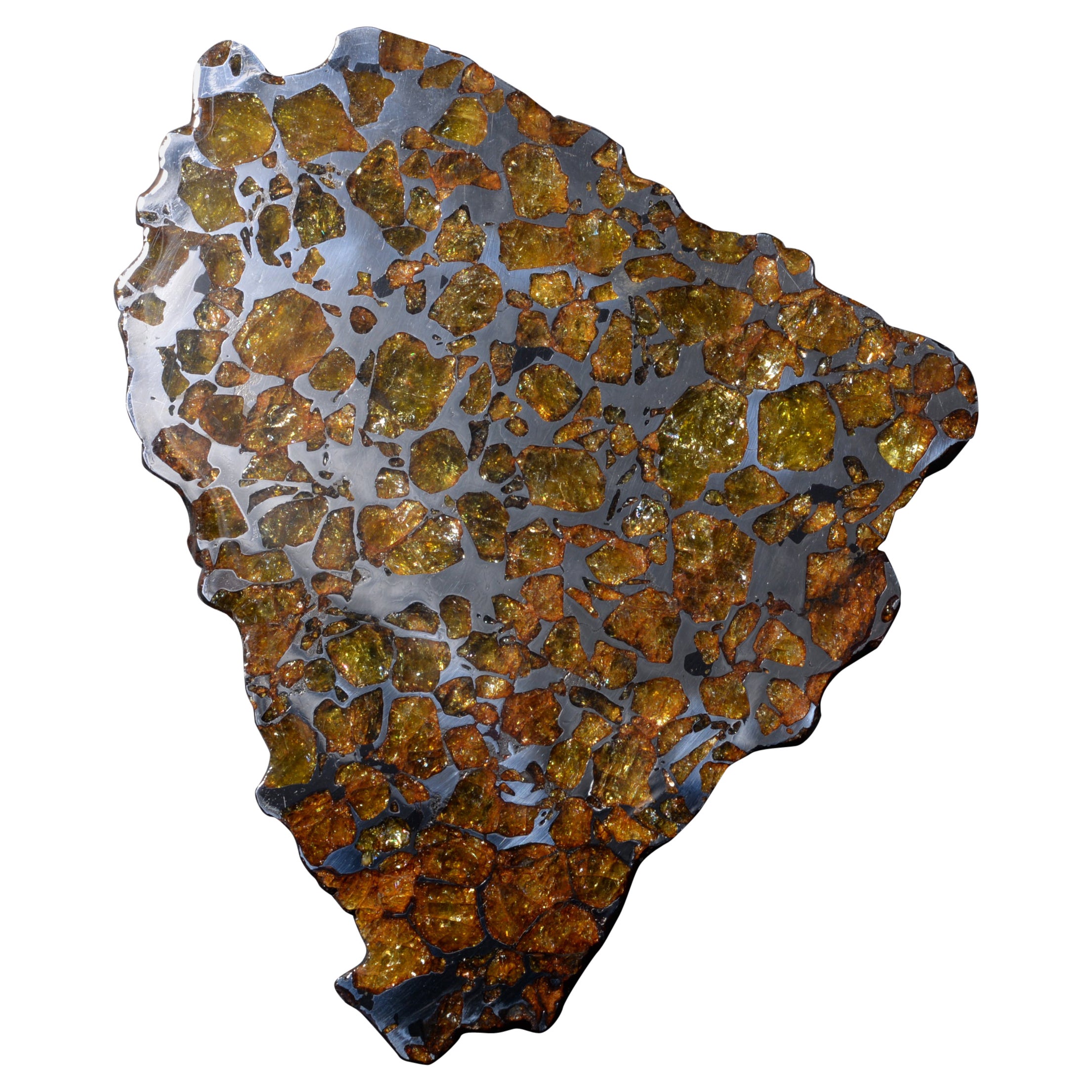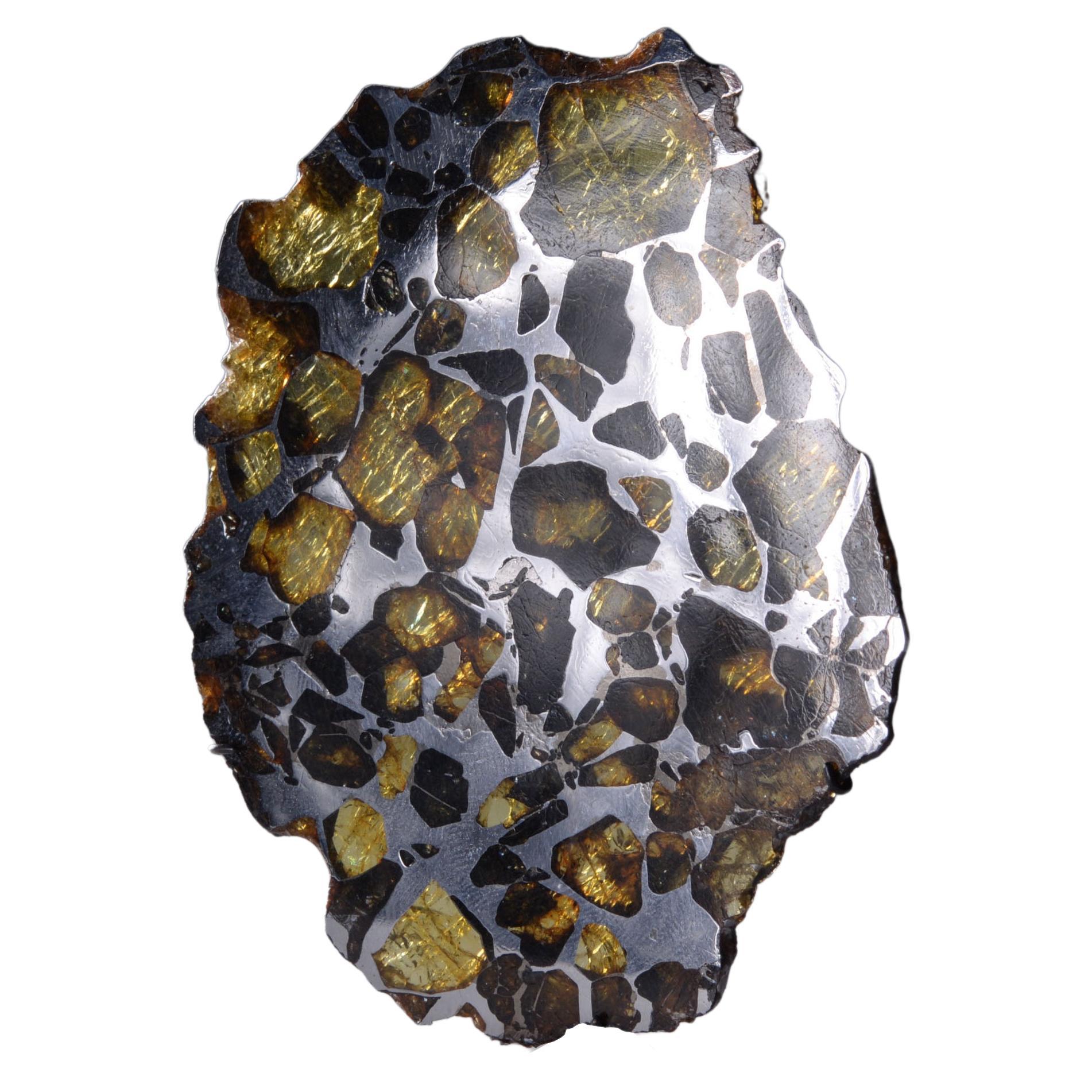Items Similar to Pre-Solar Stardust, a Piece of the Allende Meteorite
Want more images or videos?
Request additional images or videos from the seller
1 of 9
Pre-Solar Stardust, a Piece of the Allende Meteorite
About the Item
Pre-Solar Stardust - A piece of the Allende Meteorite
Carbonaceous Chondrite - CV3
Height 6.98 cm
280 g
“This individual sample of the Allende CV3 carbonaceous chondrite shows an incomplete millimeter-thick fusion crust. In crust-free patches, there are a few large white Calcium- Aluminum Inclusions (CAIs) – the oldest solids formed in the Solar System. Also present in the meteorite are tiny presolar grains that condensed in the atmospheres of dying stars billions of years before the Sun came into being.”
- Dr Alan E. Rubin, PhD Department of Earth, Planetary, and Space Sciences, UCLA
This dark-grey coloured fragment belongs to the Allende meteorite, the “Rosetta stone of planetologists.” The piece is covered in a beautiful fusion crust, which formed during Allende’s journey through our atmosphere as it was superheated to over 1700 °C.
Carbonaceous chondrites such as the present example are extremely rare, making up about 4 percent of all meteorites found on Earth. The abundant calcium–aluminium-rich inclusions found in Allende, visible in the present specimen, are the oldest known solids to have formed in the Solar System, at approximately 4.567 billion years old - these are known as ‘presolar grains’, as they predate the formation not only of our planet, but even of our sun. As such, Allende, often described as “the best-studied meteorite in history”, cited in over 14,000 peer-reviewed scientific papers, has been invaluable to scientists in deepening our understanding of the birth of the Solar System, particularly as its fragments were gathered months before the Apollo 11 mission, and so proved an important reference for the study of the returned lunar samples. Even today, samples from Allende are regarded as the highest laboratory standard in the field of planetary science across the world.
“In the early morning of Saturday, 8 February 1969 (between 0105 and 0110 Central Standard Time), a brilliant fireball was observed over much of northern Mexico and adjacent areas of Texas and New Mexico. The most spectacular phenomena were centered around the city of Hidalgo del Parral in the south-central part of the state of Chihuahua. The fireball approached from the south-southwest, and as it neared its terminal point the brilliant light was accompanied by tremendous detonations and a strong air blast.”
- Clarke et al (1971)
Provenance:
Discovered in Pueblito de Allende, Chihuahua, Mexico (26 ° 58’ N, 105 ° 19’ W), 8/2/1969, 01:05.
Subsequently deposited at the Center for Meteorite Studies Arizona State University, Temper Arizona, no. 818.53.
Deaccessioned from the above in 2009.
Published:
Meteoritical Bulletin, no. 45, Moscow (1969) reprinted Met. 5, 85-109 (1970)
ArtAncient, Extraterrestrial (2022).
- Dimensions:Height: 2.75 in (6.98 cm)Diameter: 2.41 in (6.12 cm)
- Materials and Techniques:
- Place of Origin:
- Period:
- Date of Manufacture:circa 4.5 Billion y/o
- Condition:Wear consistent with age and use.
- Seller Location:London, GB
- Reference Number:
About the Seller
5.0
Recognized Seller
These prestigious sellers are industry leaders and represent the highest echelon for item quality and design.
Established in 2008
1stDibs seller since 2014
100 sales on 1stDibs
Typical response time: 7 hours
Associations
LAPADA - The Association of Arts & Antiques DealersInternational Confederation of Art and Antique Dealers' AssociationsThe British Antique Dealers' Association
- ShippingRetrieving quote...Ships From: London, United Kingdom
- Return PolicyA return for this item may be initiated within 14 days of delivery.
More From This SellerView All
- A Piece of Mars - Martian MeteoriteLocated in London, GBMARTIAN STONE - NWA 14713 Lherzolitic shergottite 127 g “This 127-gram fragment of the NWA 14713 meteorite displays a green-black mottled exterior. The rock is a martian shergottite (a basalt) composed mainly of coarse grains of pyroxene as well as calcium-plagioclase glass. This glass, called maskelynite, formed from crystalline plagioclase when the specimen was blasted off the surface of Mars by an energetic collision. There are currently less than 350 known martian meteorites...Category
Antique 15th Century and Earlier North African Natural Specimens
MaterialsStone
- Cross Section of the Imilac MeteoriteLocated in London, GB“This 282 g interior section of the Imilac pallasite shows a large range of olivine grain sizes – there are coarse grains, grain clusters and fine-grained, crushed olivine debris. All of the olivine grains are surrounded by a matrix of metallic iron-nickel derived from the top of a molten core of a differentiated asteroid.” Dr Alan E. Rubin, PhD Department of Earth, Planetary, and Space Sciences, UCLA Imilac - interior section Stony-iron, pallasite - PMG 8 1/4 inches (20.95 CM), 282 g This complete cross-sectional slice from the Imilac meteorite...Category
Antique 15th Century and Earlier Natural Specimens
MaterialsOther
- Cross Section of the Seymchan MeteoriteLocated in London, GBCross Section from the Seymchan Meteorite Pallasite Comprising less than 0.2% of all meteorites, pallasites, made up of an iron-nickel matrix inter...Category
Antique 15th Century and Earlier Russian Natural Specimens
MaterialsIron, Nickel
- End-Cut from the Imilac MeteoriteLocated in London, GBImilac Meteorite End-Cut circa 4.5 Billion y/o Measures: 10 x 13 x 1 cm “This interior section of the Imilac pallasite shows a large range of olivine grain sizes there are coarse grains, grain clusters and fine-grained, crushed olivine debris. All of the olivine grains are surrounded by a matrix of metallic iron-nickel derived from the top of a molten core of a differentiated asteroid”. Dr Alan E. Rubin, PhD Department of Earth, Planetary, and Space Sciences...Category
Antique 15th Century and Earlier Chilean Natural Specimens
MaterialsIron, Nickel
- Complete Slice of Imilac MeteoriteLocated in London, GBThis complete cross-sectional slice from the Imilac meteorite has been prepared to reveal shimmering olivine and peridot gems embedded in an iron-nick...Category
Antique 15th Century and Earlier Natural Specimens
MaterialsOther
- Lunar MeteoriteLocated in London, GBA beautiful fragment from a lunar meteorite, among the rarest of all geological finds. This specimen belongs to NWA 11303, a feldspathic regolith breccia which formed when the shock ...Category
Antique 15th Century and Earlier Algerian Natural Specimens
MaterialsStone
You May Also Like
- Franconia MeteoriteLocated in New York, NYFound in 2002 at Franconia in Mojave, Arizona, this H5 chondrite meteorite can be found strewn amongst many other varieties of metorite in what has been coined a Dense Collection Are...Category
Antique 15th Century and Earlier American Natural Specimens
MaterialsOther
- Brahin Pallasite Meteorite SliceLocated in New York, NYThis meteorite was acquired from the Bethany Sciences collection and was once a part of the private collection of Meteorite Man Robert A. Haag. It includes an informational Certifica...Category
Antique 15th Century and Earlier Belarusian Natural Specimens
MaterialsCrystal, Other
- Genuine Muonionalusta Meteorite (5.5 grams)Located in New York, NYGenuine Muonionalusta Meteorite Slice from Norrbotten, Sweden. The Muonionalusta is a meteorite classified as fine octahedrite, type IVA (Of) which impacted in northern Scandinavia,...Category
21st Century and Contemporary Swedish Natural Specimens
MaterialsRock Crystal
- 24 Gram Brahin Meteorite SliceLocated in New York, NYThis meteorite was acquired from the Bethany Sciences collection and was once a part of the private collection of Meteorite Man Robert A. Haag. It includes an informational Certifica...Category
Antique 15th Century and Earlier Belarusian Natural Specimens
MaterialsCrystal, Other
- Seymchan Corner-Cut Pallasite MeteoriteLocated in New York, NYThe Seymchan meteorite is a pallasite meteorite found in Russia in the settlement of Seymchan. Discovered in 1967, it is one of only a few pallasite meteorites - a type of meteorite ...Category
Antique 15th Century and Earlier Russian Natural Specimens
MaterialsOther
- Soledade Meteorite Slice // 389 GramsLocated in New York, NYThis hefty approximately over 4.5 billion year old Soledade iron meteorite slice features a prominent, unique iron nickel etching. This octahedrite was discovered in 1986 as a 68 kg ...Category
Antique 15th Century and Earlier Brazilian Natural Specimens
MaterialsOther, Iron, Nickel





